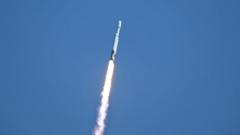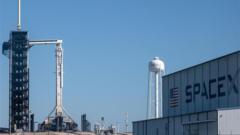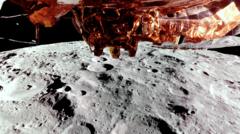The Europa Clipper, which launched after a hurricane delay, will traverse 1.8 billion miles to potentially uncover evidence of life within Europa's hidden oceans, altering humanity's understanding of life beyond Earth.
Europa Clipper Embarks on Groundbreaking Quest to Uncover Alien Life

Europa Clipper Embarks on Groundbreaking Quest to Uncover Alien Life
A NASA spacecraft launched from Florida on a mission to probe Jupiter's enigmatic moon Europa for signs of life.
A New Frontier for Life: NASA's Europa Clipper Begins Epic Voyage from Earth to Jupiter's Moon
In an ambitious move to answer one of humanity's oldest questions, NASA has launched the Europa Clipper, a spacecraft set on a decade-long journey to Jupiter's icy moon Europa. Lifted from Cape Canaveral despite hurricane delays, this spacecraft aims to search for signs of life hidden beneath Europa's thick icy crust. Scientists suspect Europa harbors a vast saltwater ocean, potentially containing twice the amount of water as Earth's oceans. First-billed to examine this cosmic enigma, the Clipper's instruments will map Europa's entire surface, fly through suspected water plumes, and collect dust particles to analyze its potential habitability. Developed at NASA's Jet Propulsion Laboratory, the spacecraft will employ gravity assists—known as the sling-shot effect—from Earth and Mars to complete its 1.8 billion-mile journey by 2030. Protected by heavy shielding against Europa's intense radiation, the Clipper will execute over 50 flybys, leveraging cutting-edge instruments like Cornell University's laser, designed to penetrate the moon's ice and reveal its hidden structure. The mission ties together an international team of scientists from prestigious institutions, promising a profound leap in space exploration without commercial incentive. As stated by planetary microbiologist Mark Fox-Powell, discovering separate origins of life could suggest a cosmic abundance of habitability, a notion set to redefine our place in the universe.
In an ambitious move to answer one of humanity's oldest questions, NASA has launched the Europa Clipper, a spacecraft set on a decade-long journey to Jupiter's icy moon Europa. Lifted from Cape Canaveral despite hurricane delays, this spacecraft aims to search for signs of life hidden beneath Europa's thick icy crust. Scientists suspect Europa harbors a vast saltwater ocean, potentially containing twice the amount of water as Earth's oceans. First-billed to examine this cosmic enigma, the Clipper's instruments will map Europa's entire surface, fly through suspected water plumes, and collect dust particles to analyze its potential habitability. Developed at NASA's Jet Propulsion Laboratory, the spacecraft will employ gravity assists—known as the sling-shot effect—from Earth and Mars to complete its 1.8 billion-mile journey by 2030. Protected by heavy shielding against Europa's intense radiation, the Clipper will execute over 50 flybys, leveraging cutting-edge instruments like Cornell University's laser, designed to penetrate the moon's ice and reveal its hidden structure. The mission ties together an international team of scientists from prestigious institutions, promising a profound leap in space exploration without commercial incentive. As stated by planetary microbiologist Mark Fox-Powell, discovering separate origins of life could suggest a cosmic abundance of habitability, a notion set to redefine our place in the universe.


















